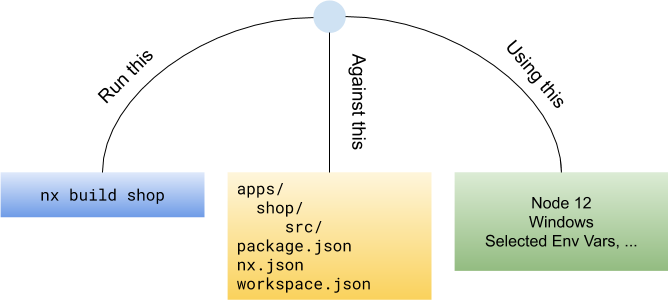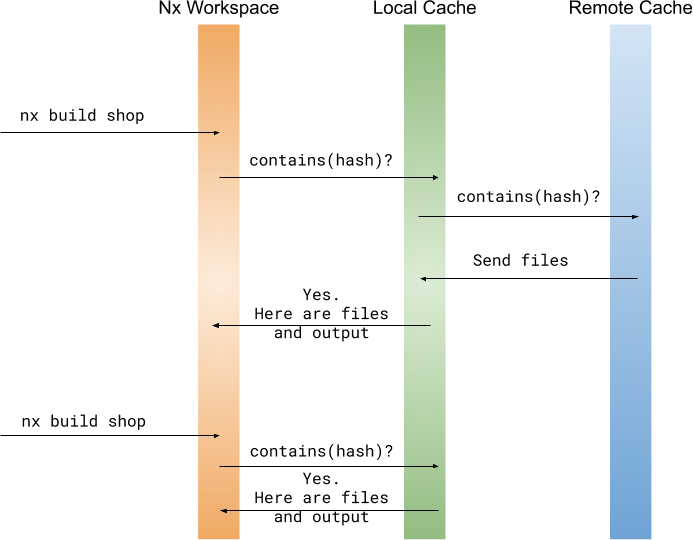Computation Caching
It's costly to rebuild and retest the same code over and over again. Nx uses a computation cache to never rebuild the same code twice. When connected to Nx cloud, you can share the computation cache with everyone working on the same project.
In order not to recompute something twice, we need two things:
- We need to store the results of the computation.
- We need to know when we are about to compute something we already computed before.
There are three things that tell Nx if something has been computed before:
Source Code Cache Inputs
The result of building/testing an application or a library depends on the source code of that project and all the source codes of all the libraries it depends on (directly or indirectly). It also depends on the configuration files like package.json, workspace.json, nx.json, tsconfig.base.json, and package-lock.json. The list of these files isn't arbitrary. Nx can deduce most of them by analyzing our codebase. Few will have to be listed manually in the implicitDependencies property of nx.json.
1{
2 "npmScope": "happyorg",
3 "implicitDependencies": {
4 "global-config-file.json": "*"
5 },
6 "projects": {},
7 "tasksRunnerOptions": {
8 "default": {
9 "options": {
10 "cacheableOperations": ["build", "test", "lint", "e2e"]
11 }
12 }
13 }
14}
Runtime Cache Inputs
Things like the version of NodeJS, whether we are running Windows or not, can affect the results of the computation but cannot be deduced statically. Those will have to be configured manually too.
1{
2 "npmScope": "happyorg",
3 "implicitDependencies": {},
4 "projects": {},
5 "tasksRunnerOptions": {
6 "default": {
7 "options": {
8 "cacheableOperations": ["build", "test", "lint", "e2e"],
9 "runtimeCacheInputs": ["node -v", "echo $IMPORTANT_ENV_VAR"]
10 }
11 }
12 }
13}
Args Cache Inputs
Finally, in addition to Source Code Cache Inputs and Runtime Cache Inputs, Nx needs to consider the arguments. I.e., nx build shop and nx build shop --prod produce different results.
Note, only the flags passed to the builder itself affect results of the computation. For instance, the following commands are identical from the caching perspective.
nx build myapp --prod
nx build myapp --configuration=production
nx run-many --target=build --projects=myapp --configuration=production
nx run-many --target=build --projects=myapp --configuration=production --parallel
nx affected:build # given that myapp is affectedIn other words, Nx does not cache what the developer types into the terminal. The args cache inputs consist of: Project Name, Target, Configuration + Args Passed to Builders.
If you build/test/lint… multiple projects, each individual build will have its own cache value and will either be retrieved from cache or run. This means that from the caching point of view, the following command:
nx run-many --target=build --projects=myapp1,myapp2is identical to the following two commands:
nx build myapp1
nx build myapp2
All Cache Inputs
So the combination of Source Code Cache Inputs, Runtime Cache Inputs, and Args Cache Inputs determine the result of the computation. If anything in the source changes, Nx needs to recompute. If anything in runtime changes, Nx needs to recompute. But if we have already computed the results, we can simply use the stored artifacts.

What is Cached
Nx works on the process level. Regardless of the tools used to build/test/lint/etc.. your project, the results will be cached.
Nx sets up hooks to collect stdout/stderr before running the command. All the output will be cached and then replayed during a cache hit.
Nx will also cache the files generated by a command. The list of folders is listed in the outputs property in workspace.json.
1{
2 "projects": {
3 "myapp": {
4 "root": "apps/myapp/",
5 "sourceRoot": "apps/myapp/src",
6 "projectType": "application",
7 "architect": {
8 "build": {
9 "builder": "@nrwl/web:build",
10 "outputs": ["dist/apps/myapp"],
11 "options": {
12 "index": "apps/myapp/src/app.html",
13 "main": "apps/myapp/src/main.tsx"
14 }
15 }
16 }
17 }
18}
If the outputs property is missing, Nx will default to caching the appropriate folder in the dist (dist/apps/myapp for myapp and dist/libs/somelib for somelib).
Local Computation Caching
Because the word "cache" appears in the description, the phrase "artifact caching" comes to mind. But this isn't the right way to think about it. What Nx does is really computation memoization. We can't choose to use or not use the cached value. There are no versions. It is transparent: Nx will skip the computation only when running the computation would have produced the same result.
By default, Nx uses a local computation cache. The cache is stored in node_modules/.cache/nx. You can change the directory as follows:
1{
2 "npmScope": "happyorg",
3 "implicitDependencies": {},
4 "projects": {},
5 "tasksRunnerOptions": {
6 "default": {
7 "options": {
8 "cacheableOperations": ["build", "test", "lint", "e2e"],
9 "cacheDirectory": "/tmp/nx"
10 }
11 }
12 }
13}
Nx stores the cached values only for a week, after which they are deleted. To clear the cache, delete the cache directory, and Nx will create a new one next time it tries to access it.
Skipping Cache
Sometimes you will want to skip the cache (e.g., if you are measuring the performance of a command). You can do it as follows
nx build myapp --skip-nx-cache
nx affected:build --skip-nx-cache
Nx Cloud and Distributed Computation Caching
Nx Cloud is a SAAS product that allows you to share the results of running build/test with everyone else working in the same workspace. Learn more at https://nx.app.
Example
Say we are the first ones building some shop app.
The nx build shop command will build the app by invoking webpack under the hood. It will create a hash key using the combination of Source Code Cache Inputs, Runtime Cache Inputs, and Args Cache Inputs. Nx then will check its local cache to see if this combination has already been built on this machine. If the answer is "no", it will check the Nx Cloud cache (if the workspace is connected to it) to see if someone else has already built it. If the answer is "no", it will run the build.
It will set up hooks to collect stdout/stderr, and once the build is complete, it will store the command line output into a file in the local cache. It will also copy the produced files there as well. After that it will spawn a separate process to upload the artifacts to the Nx Cloud cache.
If we rerun the same command, Nx will find the artifact in the local cache and will replay the output from it and will restore the necessary files.
Imagine someone else on the team is trying to build nx build shop. As before Nx will use Source Code Cache Inputs, Runtime Cache Inputs, and Args Cache Inputs to get the computation hash key. It will then check the local cache. The result won't be there, so it will check the remote cache. It will find the record there, so it will download it into its local cache first and then print the stored stdout/stderr and copy the files to the place where they would normally be created. The terminal output and the created files are exactly the same as if the person ran the computation themselves.
The "someone else" in this scenario doesn't have to be a real person. For instance, every CI run will likely use a different agent. When the agents can all access the same remote cache, the CI time goes down drastically.

The nx test shop command, which in this case uses Jest, works similarly. The combination of Source Code Cache Inputs, Runtime Cache Inputs, and Args Cache Inputs determines the computation. The command won't emit any files, but the terminal output will be captured and stored.
Caching and Affected
In addition to the caching, which works against the current state of the codebase and the environment, Nx also is able to look at the code change itself (e.g., PR), and figure out what can be broken by it, and only rebuild and retest what is affected. Why use both?
Affected and caching are used to solve the same problem: minimize the computation. But they do it differently, and the combination provides better results than one or the other.
The affected command looks at the before and after states of the workspaces and figures out what can be broken by a change. Because it knows the two states, it can deduce the nature of the change. For instance, this repository uses React and Angular. If a PR updates the version of React in the root package.json, Nx will know that only half of the projects in the workspace can be affected. It knows what was changed--the version of React was bumped up.
Caching simply looks at the current state of the workspace and the environment (e.g., version of Node) and checks if somebody already ran the command against this state. Caching knows that something changed, but because there is no before and after states, it doesn't know the nature of the change. In other words, caching is a lot more conservative.
If we only use affected, the list of projects that will be retested is small, but if we test the PR twice, we will run all the tests twice.
If we only use caching, the list of projects that will be retested is larger, but if we test the PR twice, we will only run tests the first time.
Using both allows us to get the best of both worlds. The list of affected projects is as small as it can be, and we never run anything twice.